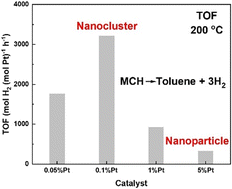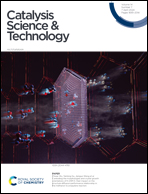Insights into size effects of Pt/Al2O3 catalysts on hydrogen production from methylcyclohexane dehydrogenation†‡
Abstract
Liquid organic hydrogen carriers (LOHCs) have been considered as a promising technique for hydrogen storage and transportation. In this study, we investigated the impacts of Pt size on the catalytic performance of Pt/Al2O3 catalysts for the abstraction of H2via dehydrogenation of methylcyclohexane (MCH), one of the most desired LOHC candidates. As the Pt loading increases from 0.05% to 5%, Pt species transition from nanoclusters to well-defined nanoparticles with the Pt size increasing from ∼0.7 nm to 1.7 nm. During MCH dehydrogenation, the turnover frequency (TOF) displays a volcano dependence on the Pt size, as the 0.1% Pt/Al2O3 sample with medium Pt size exhibits the highest atomic efficiency. Furthermore, the catalyst stability of Pt/Al2O3 samples is also dependent on the Pt size with the small Pt size in the 0.05% Pt/Al2O3 sample leading to fast catalyst deactivation due to the accumulation of coke on the Pt active sites. In summary, this study underscores the importance of Pt size to the activity and stability of Pt/Al2O3 in MCH dehydrogenation, providing new insights into the catalyst design for LOHC applications.



 Please wait while we load your content...
Please wait while we load your content...